Most people think creating a cozy living room is about adding a chunky knit throw and some scented candles. Design blogs and home improvement shows repeat this simple formula constantly. Here’s what they’re not telling you: true coziness isn’t an aesthetic you can buy; it’s a feeling you have to architect.
As an interior designer with a background in environmental psychology, I’ve analyzed hundreds of spaces to understand what truly makes us feel safe, calm, and restored. The surprising truth is that our sense of comfort is a deeply primal response. It’s less about the fluff and more about how color saturation, light sources, and even spatial pathways speak to the subconscious parts of our brain. These 20 evidence-backed strategies will show you how to move beyond surface-level decorating and intentionally craft a space that provides genuine psychological sanctuary.
Essential Coziness Fundamentals: Cultivating Sensory Comfort (Part 1)
Before we can get to the more sophisticated layers, we have to master the basics. This isn’t about style—it’s about biology. True coziness starts with creating a sensory environment that tells your nervous system it’s safe to stand down. These first steps are the non-negotiable foundation for building a space that feels like a genuine embrace.
1. Leveraging Warm Hue Saturation for Innate Tranquility
Our brains are wired to equate warm colors with safety and energy—think of a campfire’s glow or a sunset. Hues like terracotta, soft gold, and even deep reds trigger a primal sense of comfort long before our conscious mind registers the design. The simplest way to start is with a foundational warm tone on a major wall or in a large area rug. This one move establishes an immediate baseline of visual warmth, welcoming you in on a subconscious level.
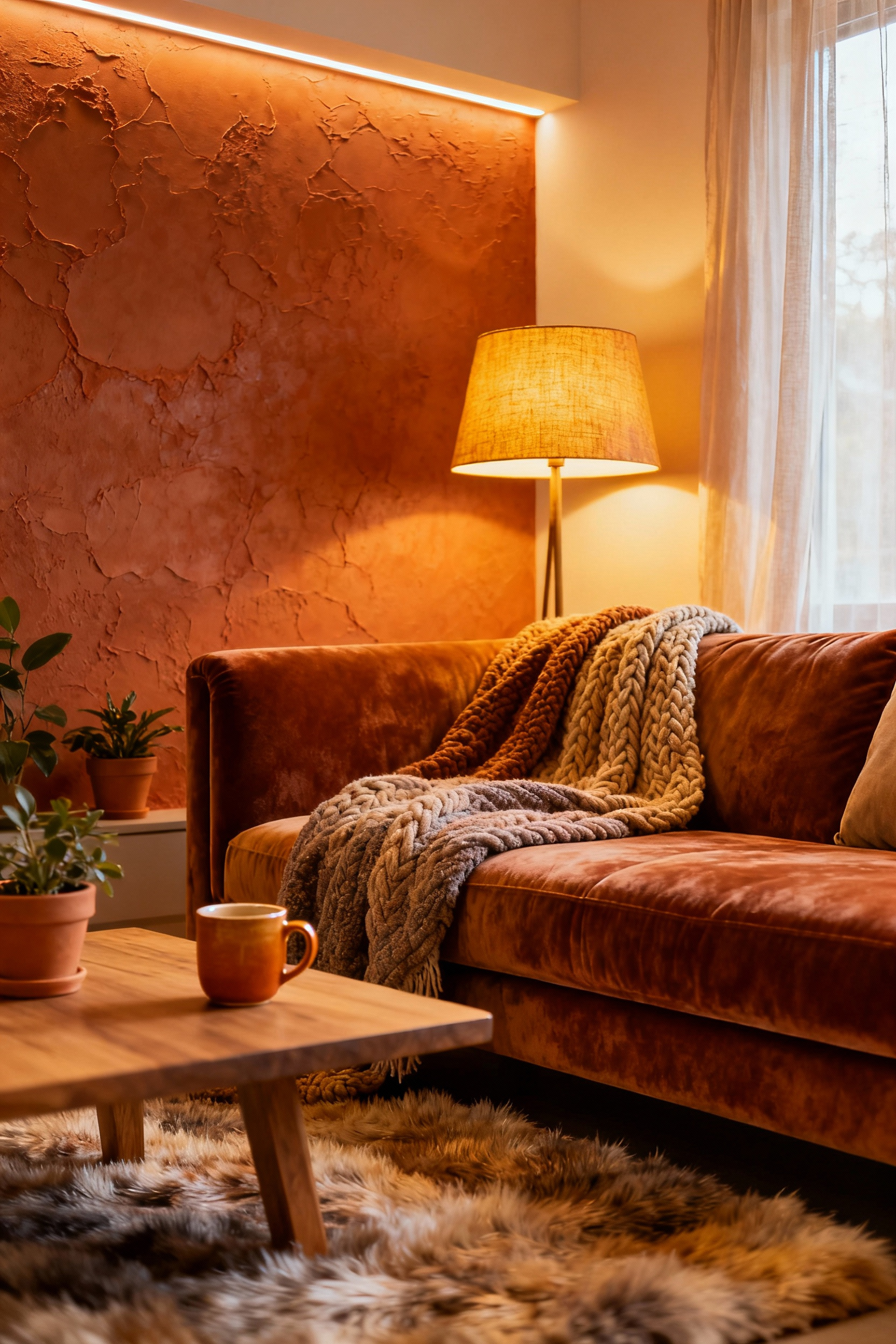
Building on that, you can begin to play with saturation. Here’s what’s interesting: a pale, buttery yellow offers a gentle, uplifting calm, while a deep, moody ochre creates a powerful sense of enclosure and intimacy—perfect for a reading nook. In my color psychology practice, I’ve noticed clients are often afraid of deep saturation, but when they finally commit to a rich, warm color in a small space, they almost always report that the room feels more expansive and protective, not smaller. The key is to select the emotional weight you want a specific area to have, then choose the saturation to match, creating an enveloping warmth that never feels flat.
2. Strategic Placement of Ambient Light Sources for Psychological Security
Harsh, central overhead lighting is the enemy of coziness. Psychologically, it puts us on high alert, mimicking the unfiltered glare of midday sun and eliminating protective shadows. The first step is to turn it off. Instead, place three or four lamps at varying heights around the room. Using warm-toned bulbs (around 2700 Kelvin) diffuses light, creating soft pools of illumination that make a space feel secure and contained.
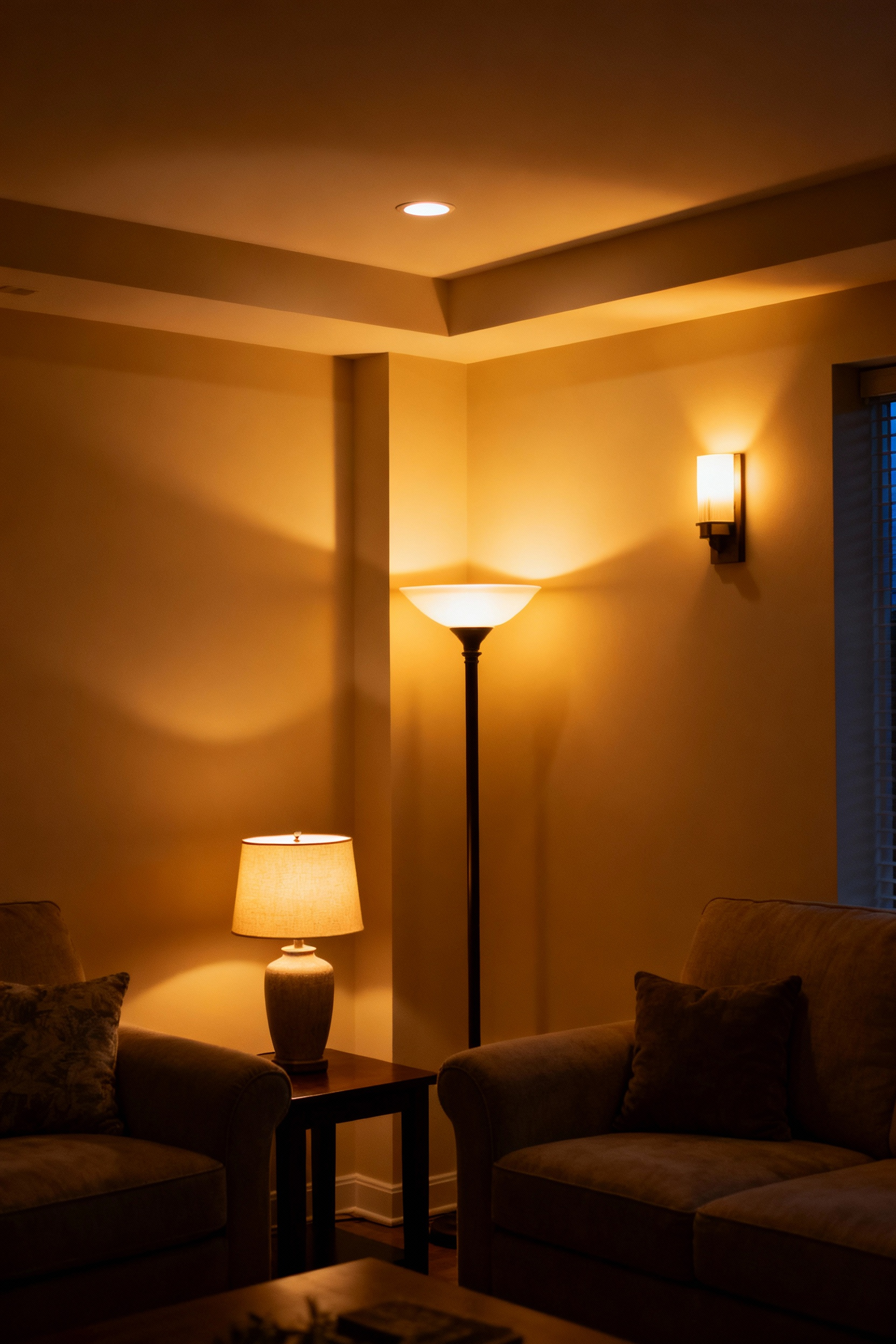
From there, think in layers. Wall sconces that wash light upwards and downwards add depth, while a small, focused lamp on a bookshelf creates a point of interest without disrupting the overall calm. This layered approach eliminates jarring shadows, which our brains can interpret as potential threats, and builds a rich visual landscape. It encourages your eye to wander slowly rather than darting around, a physical sign of a relaxed state. A truly cozy living room feels like a softly lit haven, not an interrogation room.
3. Integrating Plush Textural Layers to Evoke Haptic Pleasure
Our sense of touch is profoundly linked to our feeling of comfort. Haptic pleasure—the positive feedback we get from touching different surfaces—is a powerful tool. The easiest way to start is with the obvious: a truly soft, substantial throw or a few deep, velvety cushions. These elements are visual promises of comfort that invite physical interaction, starting a sensory conversation before you’ve even sat down.
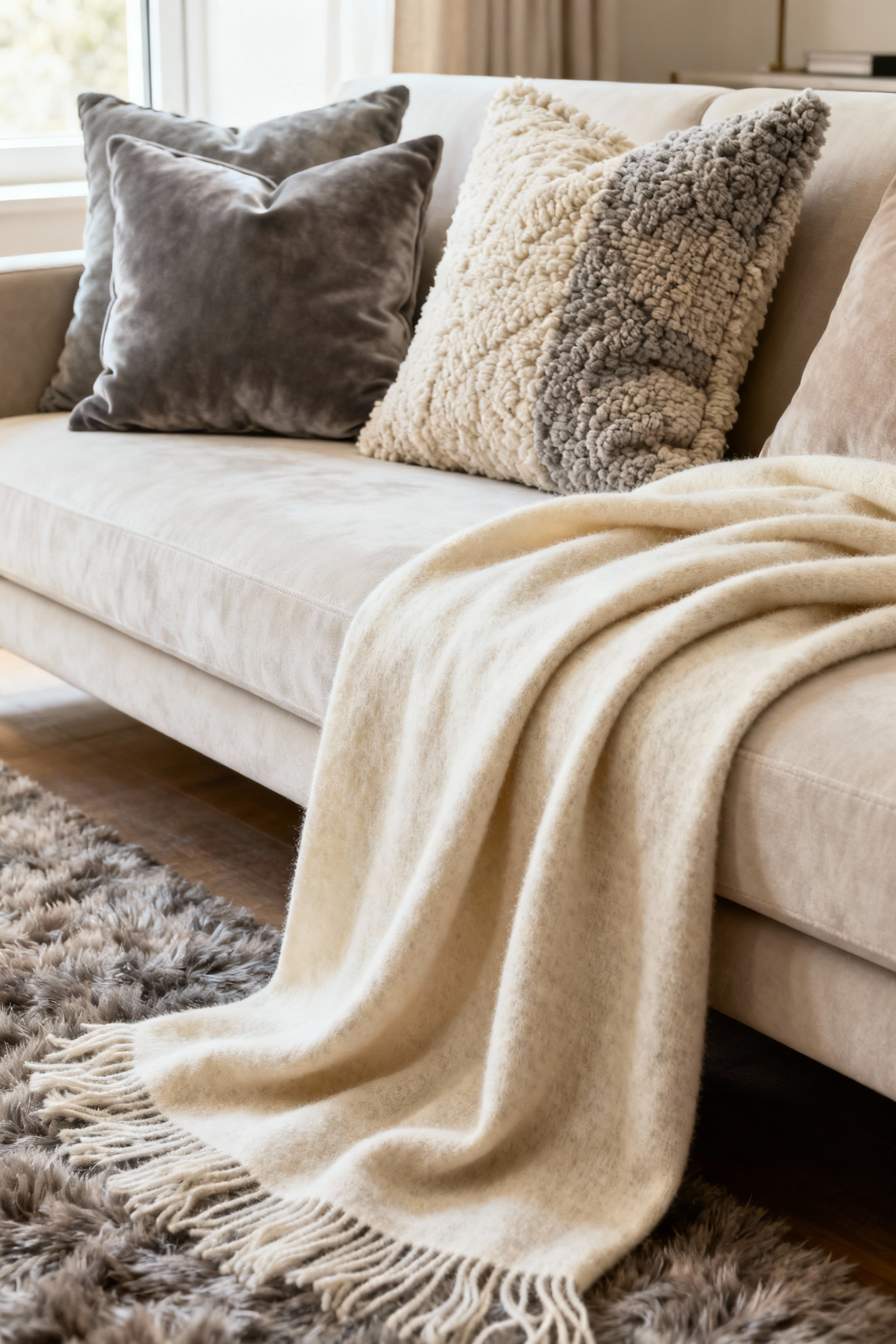
The next level is to curate a symphony of textures. Don’t just stop at one type of soft. The rough, nubby feel of a wool blanket offers a different kind of comfort than the smooth nap of a velvet ottoman. I’ve seen this play out when a client pairs a sleek leather chair with a fuzzy sheepskin rug; the contrast is what makes it so compelling. By mixing materials—bouclé, linen, chunky knits, faux fur—you create a rich, multidimensional landscape that your hands (and eyes) will want to explore, making the room feel more lush and interesting.
4. Establishing Defined Zones with Thoughtful Furniture Grouping
Furniture pushed against the walls creates a visual and social void in the center of a room, making it feel like a waiting room. The most crucial first step is to pull your seating together. Arrange a sofa and chairs to face each other around a central point, like a coffee table. This simple act of ‘floating’ your furniture creates an immediate sense of intimacy and encourages conversation. It carves out a human-scaled zone dedicated to connection.
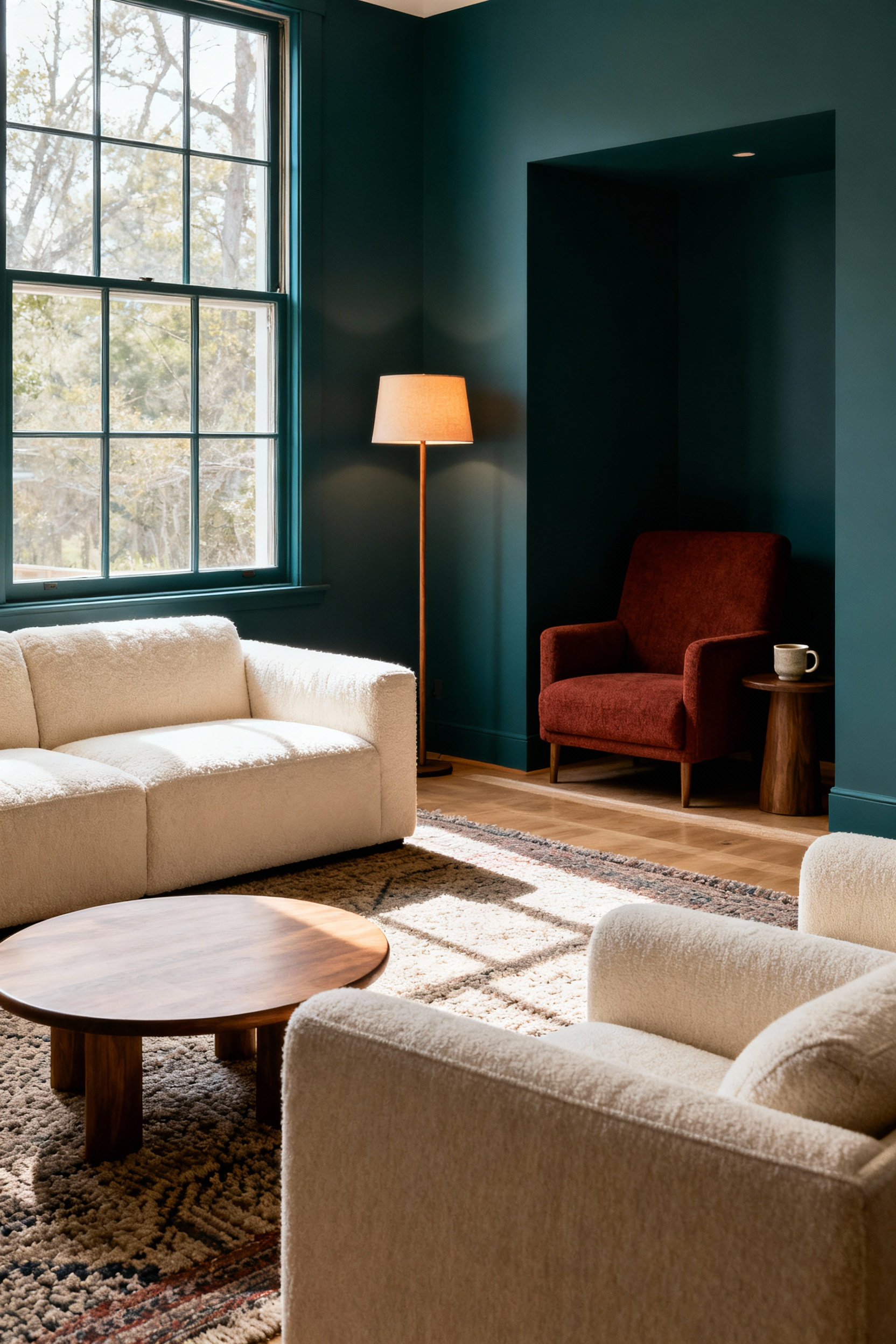
Once your primary conversation zone is set, you can create smaller, secondary zones. Use an area rug to anchor a reading nook with a single armchair and lamp. A long console table placed behind a sofa can subtly divide the main seating area from a walkway or a small desk space. What I tell my clients is that these aren’t walls; they’re gentle suggestions. They allow a cozy living room to support different activities at once—one person reading, others chatting—without feeling chaotic, giving each person their own pocket of comfort.
Essential Coziness Fundamentals: Cultivating Sensory Comfort (Part 2)
Building on the visual and tactile foundations, there’s a powerful and often-overlooked tool that directly impacts our physiological state. This next principle moves beyond what feels good on the surface to what actively calms our bodies from the inside out, offering a deeper, more therapeutic layer of comfort.
5. Harnessing the Power of Weighted Throws for Grounded Relaxation
A standard throw provides warmth, but a weighted throw provides something much deeper: a sense of security. The gentle, consistent pressure it applies across the body is called Deep Pressure Touch, a type of therapeutic stimulation that signals your nervous system to calm down. For anyone feeling anxious or untethered, simply draping a weighted throw across your lap can be incredibly grounding, offering a primal feeling of being held and protected.
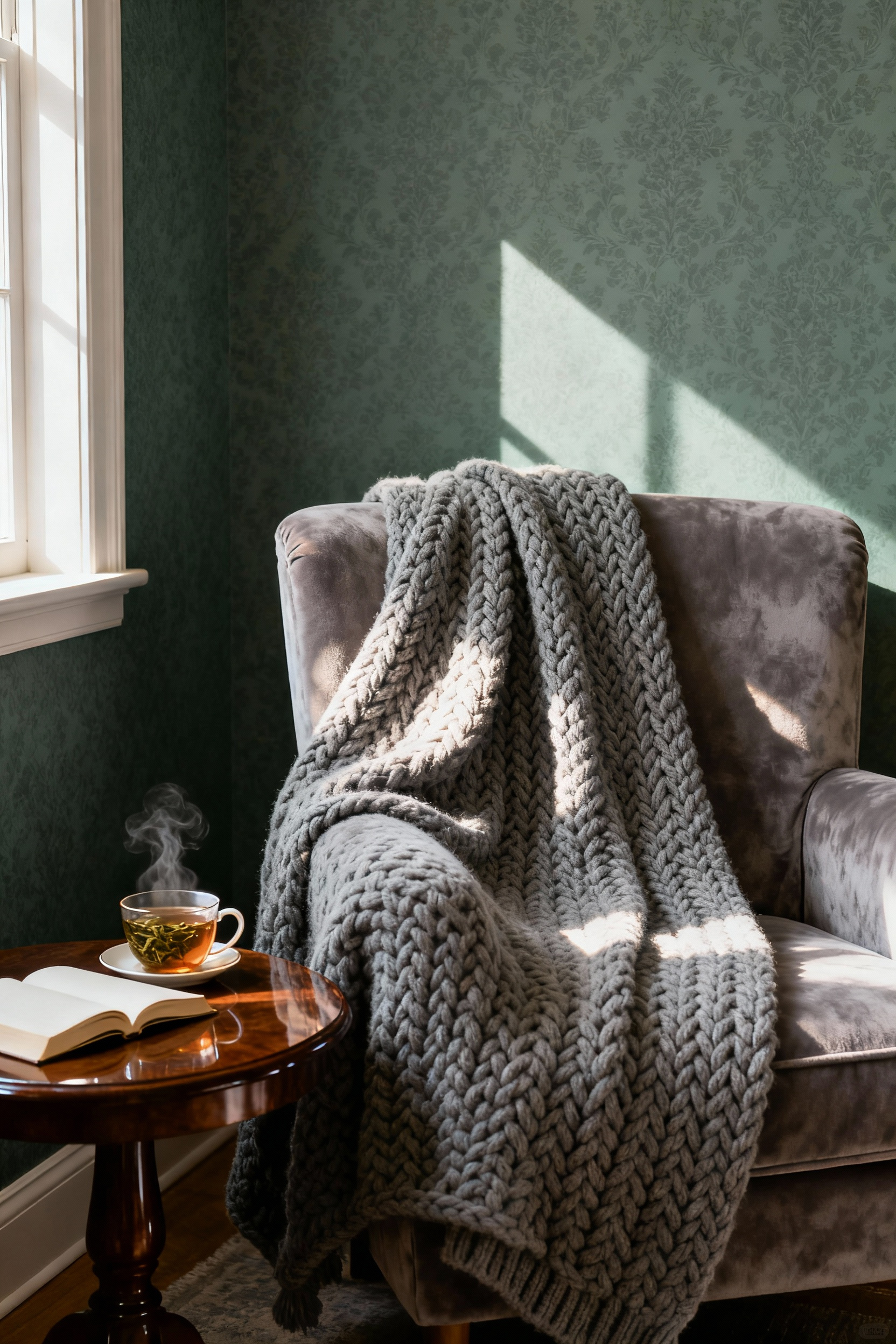
From a design perspective, this elevates a simple textile from an accessory to a functional wellness tool. When selecting one for your cozy living room, think about its integration. Don’t just fold it up; drape it invitingly over a reading chair or at the end of a sofa. Choose one with a soft, breathable cover like cotton or bamboo so it doesn’t get too hot. This isn’t just about adding another soft object; it’s about intentionally placing a therapeutic element in your space that encourages moments of genuine rest and physiological calm.
Elevating Your Cozy Living Approach: Harmonizing Elements (Part 1)
With the fundamentals in place, we can begin to harmonize them into a more sophisticated composition. This is where we move from adding individual cozy elements to orchestrating an environment where light, texture, and sound work together. This is the difference between a room with cozy things and a room that is fundamentally cozy.
6. Orchestrating Diverse Light Temperatures to Simulate Natural Circadian Rhythms
Our bodies are designed to sync with the sun’s shifting light. We can mimic this natural cycle indoors to promote better sleep and a deeper sense of well-being. Start by replacing all your bulbs with dimmable, warm-toned LEDs (around 2700K) for general evening use. This warm light supports melatonin production, telling your brain it’s time to wind down.
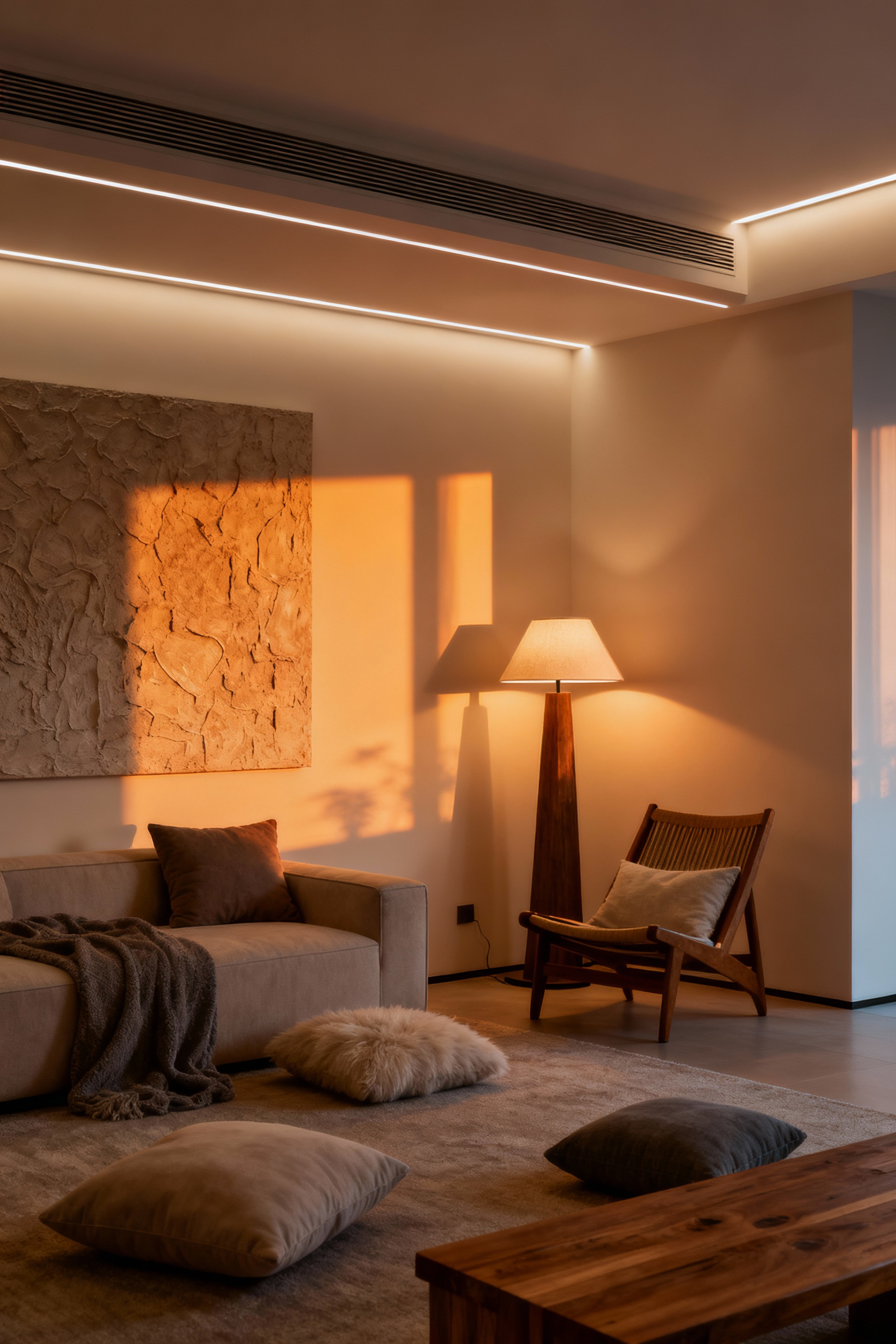
For a more advanced approach, use smart lighting to automate these shifts. You can program your lights to have a brighter, slightly cooler tone during the day (around 3500-4000K) for focus, then automatically warm and dim as sunset approaches. This isn’t just about setting a mood; it’s about using light as a bio-regulator. From my work in environmental psychology, I can tell you that aligning your home’s light with natural circadian rhythms is one of the most powerful—and overlooked—ways to improve both your mood and your sleep quality. Your cozy living room becomes an environment that actively helps your body regulate itself.
7. Curating Tactile Material Pairings for Enriched Sensory Depth
Beyond simply adding soft things, the art of coziness lies in the contrast between them. Think about how a rough, hand-hewn wooden coffee table makes a soft, plush rug feel even more luxurious. It’s the juxtaposition that creates a rich, layered experience. Start by pairing two contrasting materials: the cool smoothness of a marble side table against the nubby texture of a linen sofa.
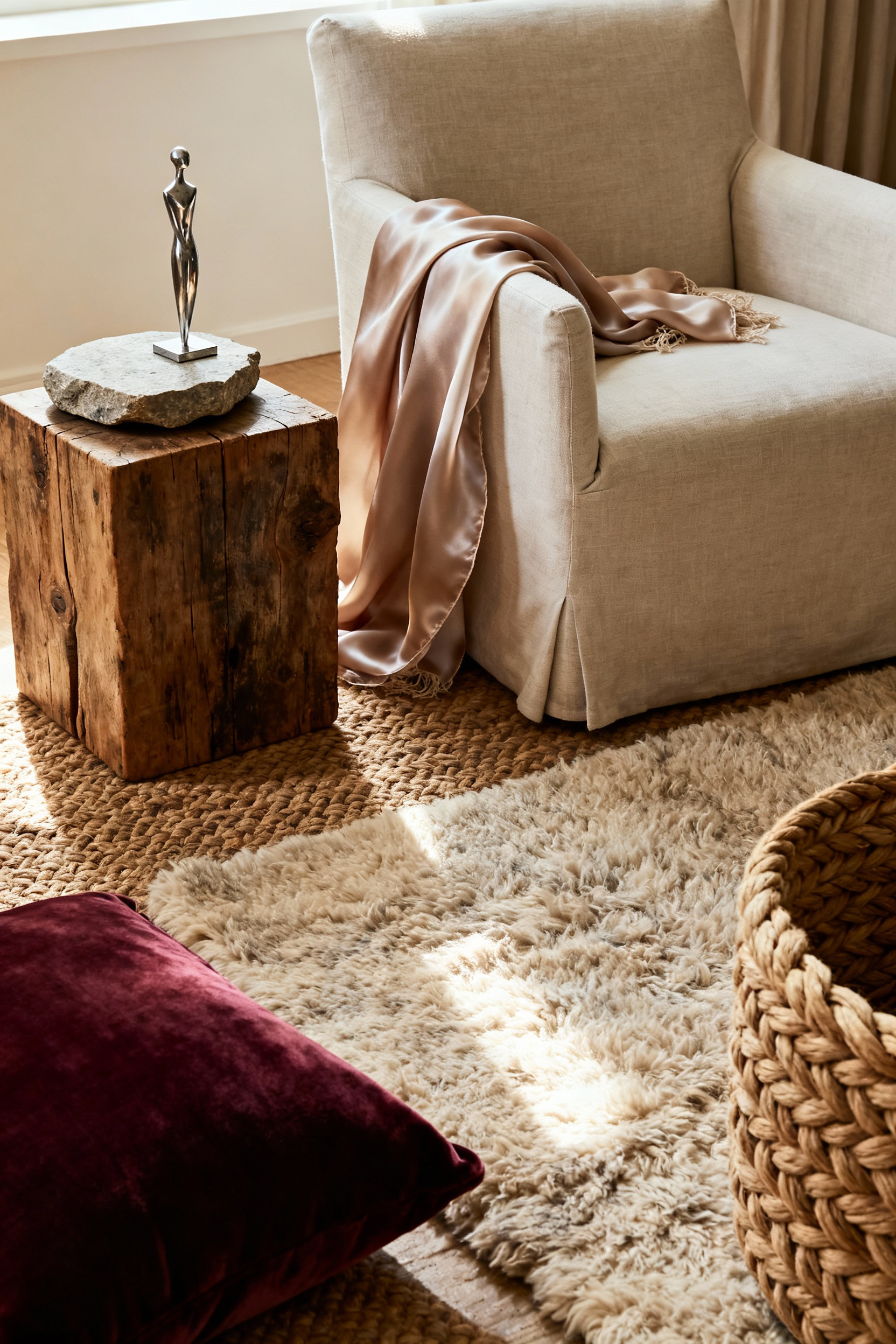
This deliberate pairing keeps the senses engaged and prevents a space from feeling one-note. What really gets me is when I see a room where every texture is roughly the same; it’s visually and tactically boring. Instead, think like a chef creating a dish. Combine hard and soft, rough and smooth, matte and glossy. A leather-bound book on a felted wool ottoman, a ceramic vase on a raw silk runner—these combinations create a dynamic sensory landscape that makes your cozy living room feel thoughtfully curated and endlessly interesting to touch and see.
8. Employing Soft Acoustic Buffering Through Textiles and Wall Hangings
A room with a lot of hard surfaces—wood floors, large windows, bare walls—will feel echoey and unsettling. Sound bounces around, creating a subtle but persistent harshness. The most effective way to combat this is with soft materials that absorb sound. An area rug is non-negotiable, but don’t stop there.
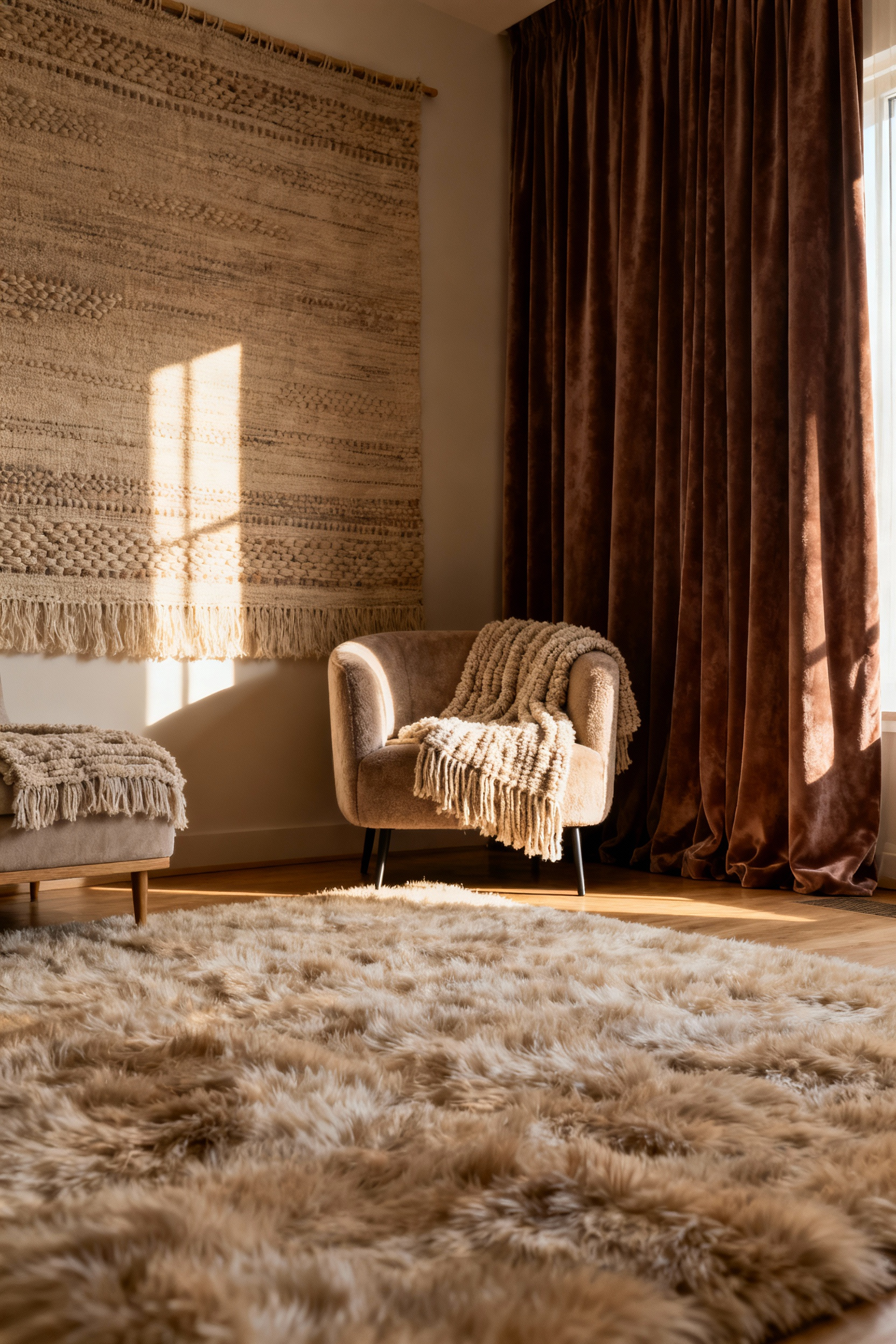
Heavy, lined curtains in a fabric like velvet or a dense linen will do wonders for dampening outside noise and interior echo. Upholstered furniture is a natural sound absorber, as are bookshelves filled with books (the uneven paper surfaces are great at diffusing sound waves). I learned this when designing a city apartment with huge windows; the view was stunning, but the noise was jarring. Adding heavy drapes and a large, textural wall tapestry completely transformed the space from a stylish echo chamber into a serene, quiet retreat. Your goal is to create acoustic coziness, a quiet envelope that makes the room feel insulated and private.
9. Optimizing Anthropometric Seating for Prolonged Comfort and Support
A sofa that you sink into might feel great for five minutes, but if it doesn’t offer any support, it quickly becomes uncomfortable. True comfort is about balancing that initial plushness with good ergonomics. This science of designing for the human body, or anthropometrics, is key. When you sit, your feet should be able to rest comfortably on the floor, and the seat shouldn’t be so deep that you have to perch on the edge.
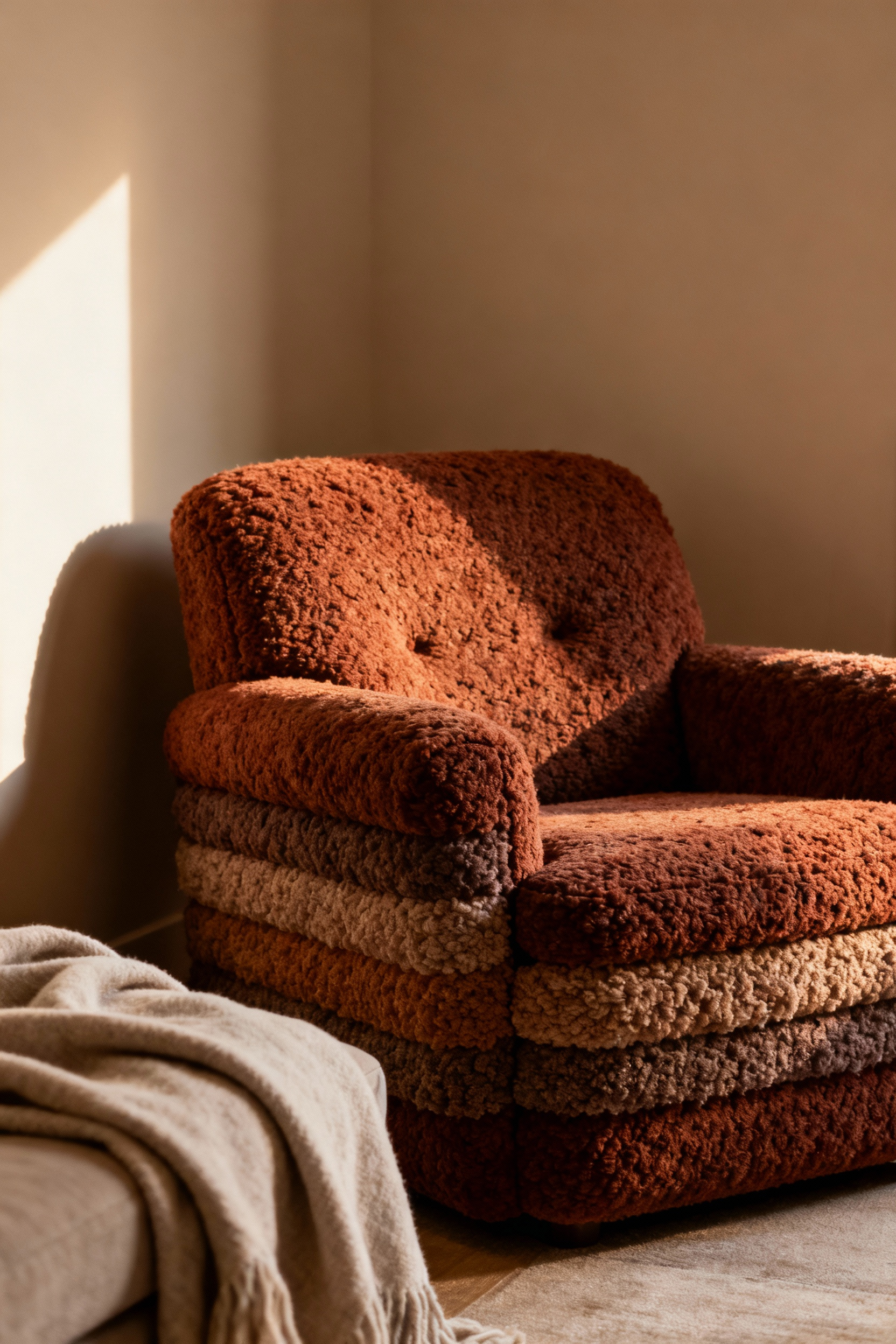
For a truly cozy living room, every seat should serve a purpose and be optimized for it. A chair meant for long reading sessions needs excellent lumbar support and a place to rest your head. A sofa for conversation might be a bit firmer and shallower to keep people engaged. Years of professional experience have taught me that the “sit test” is crucial, but think beyond the first impression. How will this feel after watching a two-hour movie? True coziness is comfort that lasts, allowing for hours of uninterrupted relaxation.
Elevating Your Cozy Living Approach: Harmonizing Elements (Part 2)
As we refine our space, we start to see how everything is connected. The most advanced form of harmony isn’t just about the objects in the room, but the empty space between them. How we move through a room profoundly affects how we feel within it, transforming a collection of furniture into a seamless, intuitive experience.
10. Designing Intentional Pathways to Facilitate Unhindered Flow and Calm
Have you ever felt a tiny, persistent flicker of irritation because you have to constantly skirt a piece of furniture? That’s friction. And a cozy living room has none of it. Creating calm isn’t just about what you add, it’s about making movement effortless. At its core, this means ensuring your primary pathways—from the doorway to the sofa, for instance—are clear and wide enough for easy passage.
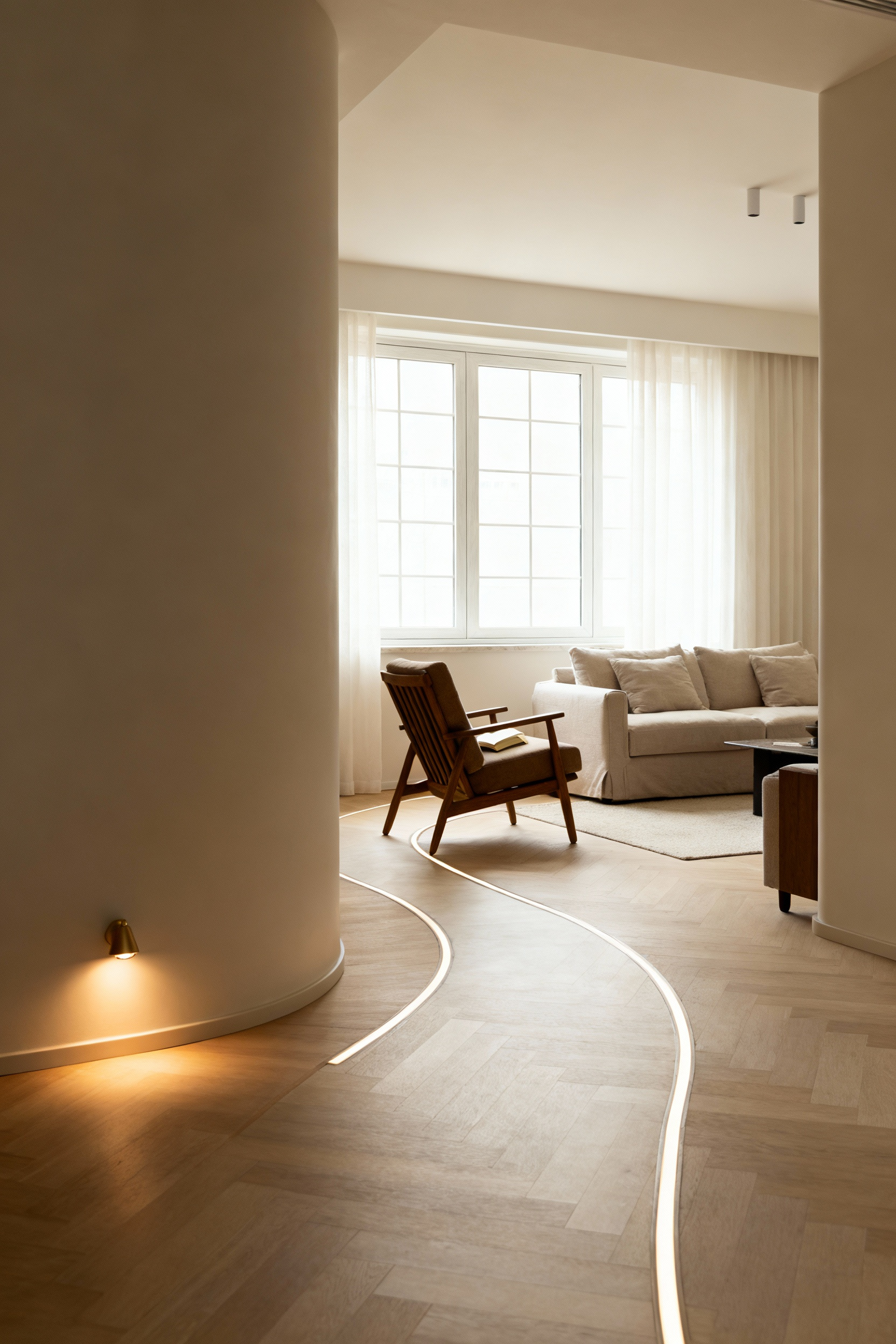
But here’s where it gets interesting: these pathways aren’t just empty space; they are a design tool. You can use furniture to create a gentle, meandering flow that encourages you to slow down, rather than a straight line that rushes you through. Arrange your seating to guide movement around a conversation zone, not through it. This careful choreography of “negative space” is what makes a room feel intuitive and graceful. It’s an invisible architecture of ease that removes subconscious tension and lets you fully relax.
Advanced Coziness Strategies: Architecting Emotional Resilience (Part 1)
Now we move beyond simple comfort into creating a space that actively restores you. These strategies are about architecting an environment that buffers you from the stresses of the outside world and nurtures your emotional well-being. This is where design becomes a form of self-care.
11. Implementing Biomimetic Principles Through Natural Elements for Restorative Appeal
Biomimicry is the practice of learning from and mimicking strategies found in nature. For interior design, it goes far beyond just adding a potted plant. Our brains are hardwired to respond positively to the patterns and forms of the natural world—it’s a phenomenon known as biophilia. Simply being exposed to these elements can lower stress and improve cognitive function.
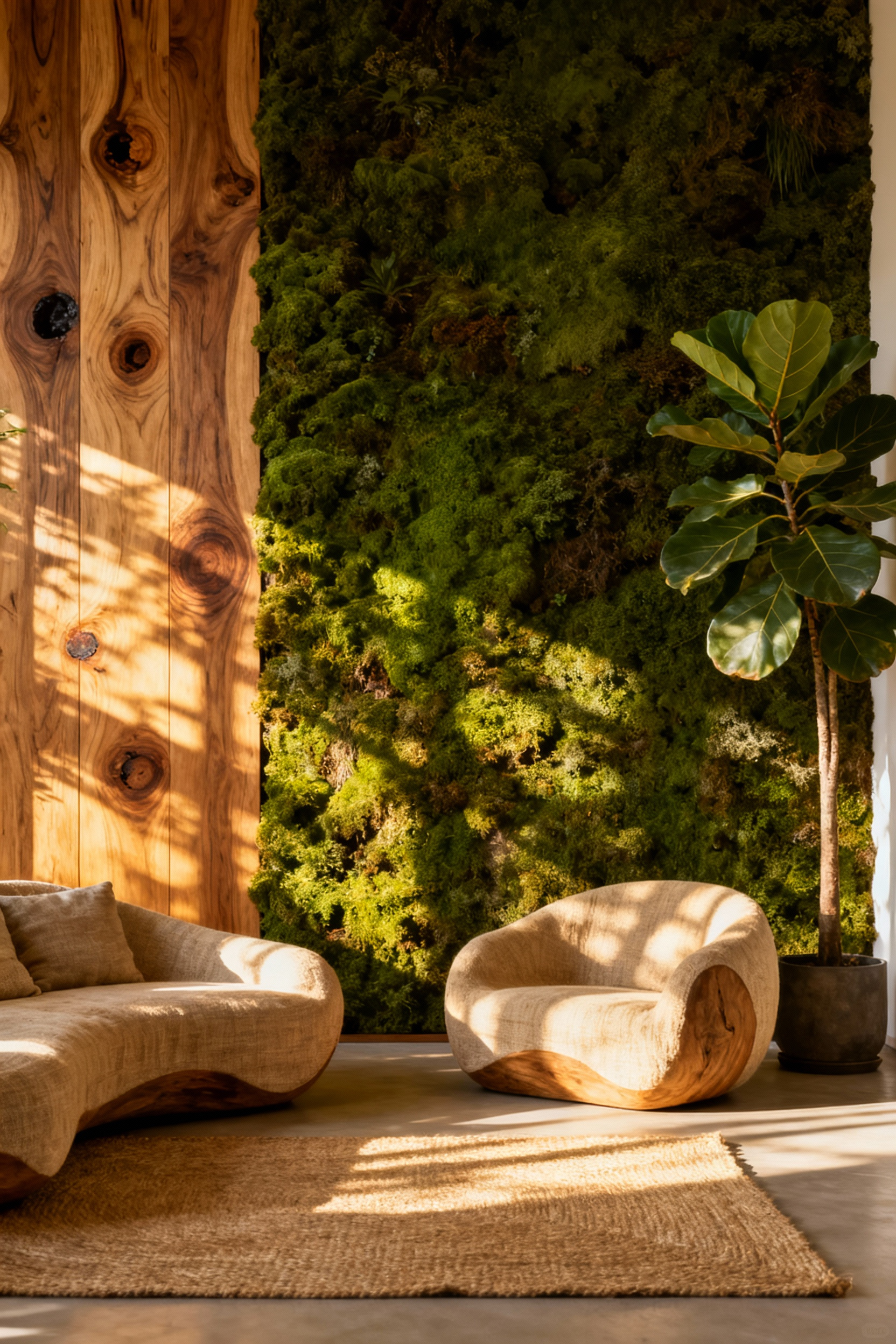
Instead of just adding a plant, think about how nature structures itself. Incorporate fractal patterns (the endlessly repeating patterns you see in ferns or snowflakes) through textiles or artwork. Use layered lighting to mimic the way sunlight dapples through a forest canopy. Choose furniture with soft, organic lines over harsh, rigid angles. In my professional experience, introducing elements that subtly echo nature—a coffee table with a live wood edge, a rug with a pattern like rippling water—has a much deeper restorative effect than simply using green paint. Your cozy living room becomes a place that feels as alive and soothing as nature itself.
12. Strategizing Focal Points with Deliberate Asymmetry to Avoid Visual Fatigue
Perfect symmetry can be beautiful, but it can also be boring and static. Our brains process it very quickly and then lose interest. Deliberate asymmetry, on the other hand, keeps the eye engaged, creating a sense of dynamic balance that feels more alive and natural. A room that’s too perfectly mirrored can actually create visual fatigue.
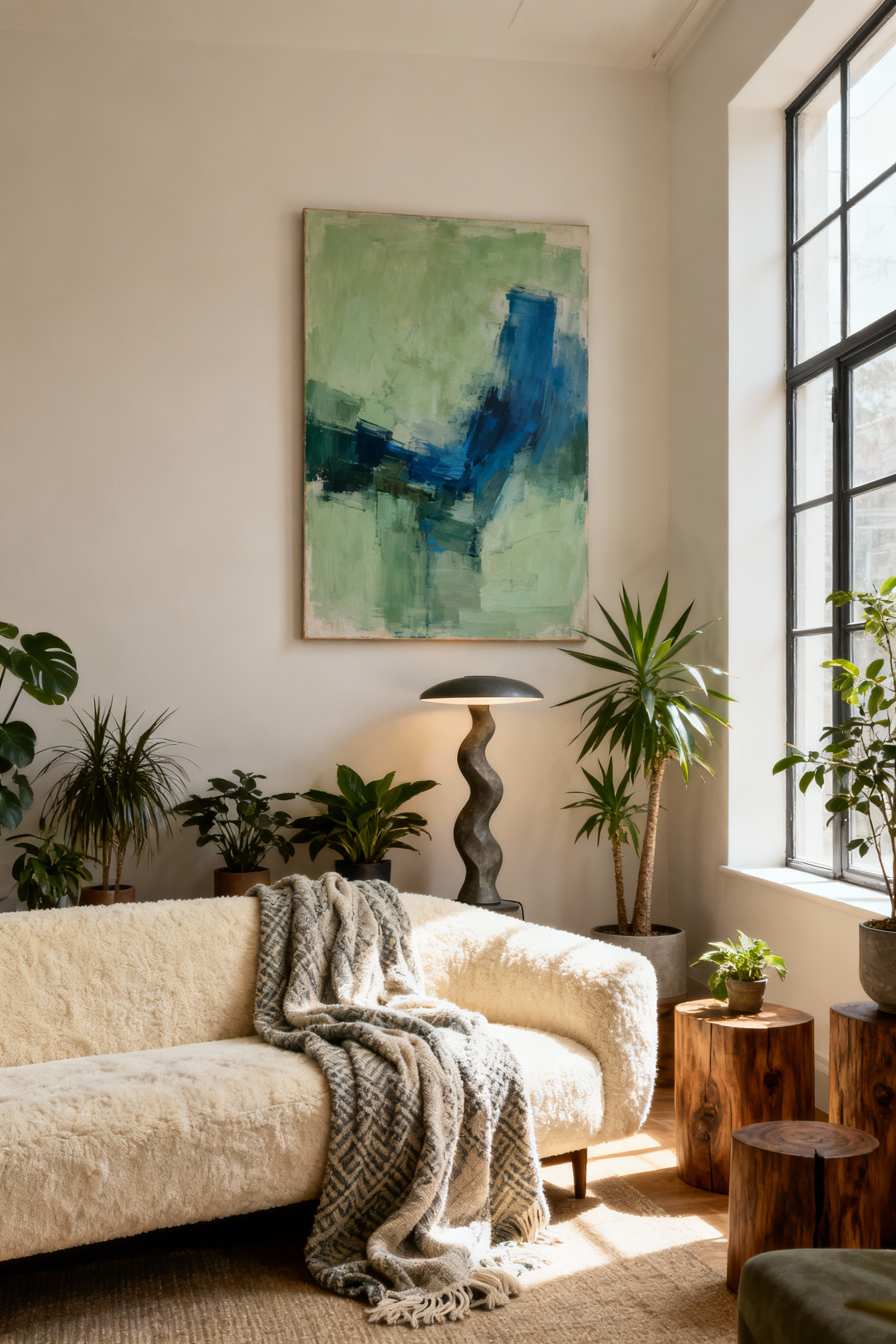
So instead of two identical lamps on either side of a fireplace, try a tall floor lamp on one side and a lower, heavier armchair on the other. It’s about balancing visual weight, not matching objects. Arrange a gallery wall with one large piece off-center, balanced by a constellation of smaller frames. This creates a subtle visual tension that is much more interesting and sophisticated, encouraging your eye to dance around the room rather than landing on one static picture.
13. Mastering the Art of Patina Integration for Depth and Authenticity
New things are nice, but objects that show their history have soul. Patina—the soft sheen that develops on surfaces like wood, leather, and metal over time—is the visual story of a life lived. Integrating pieces with patina is one of the fastest ways to give a cozy living room a sense of depth and authenticity that you can’t get from a showroom.
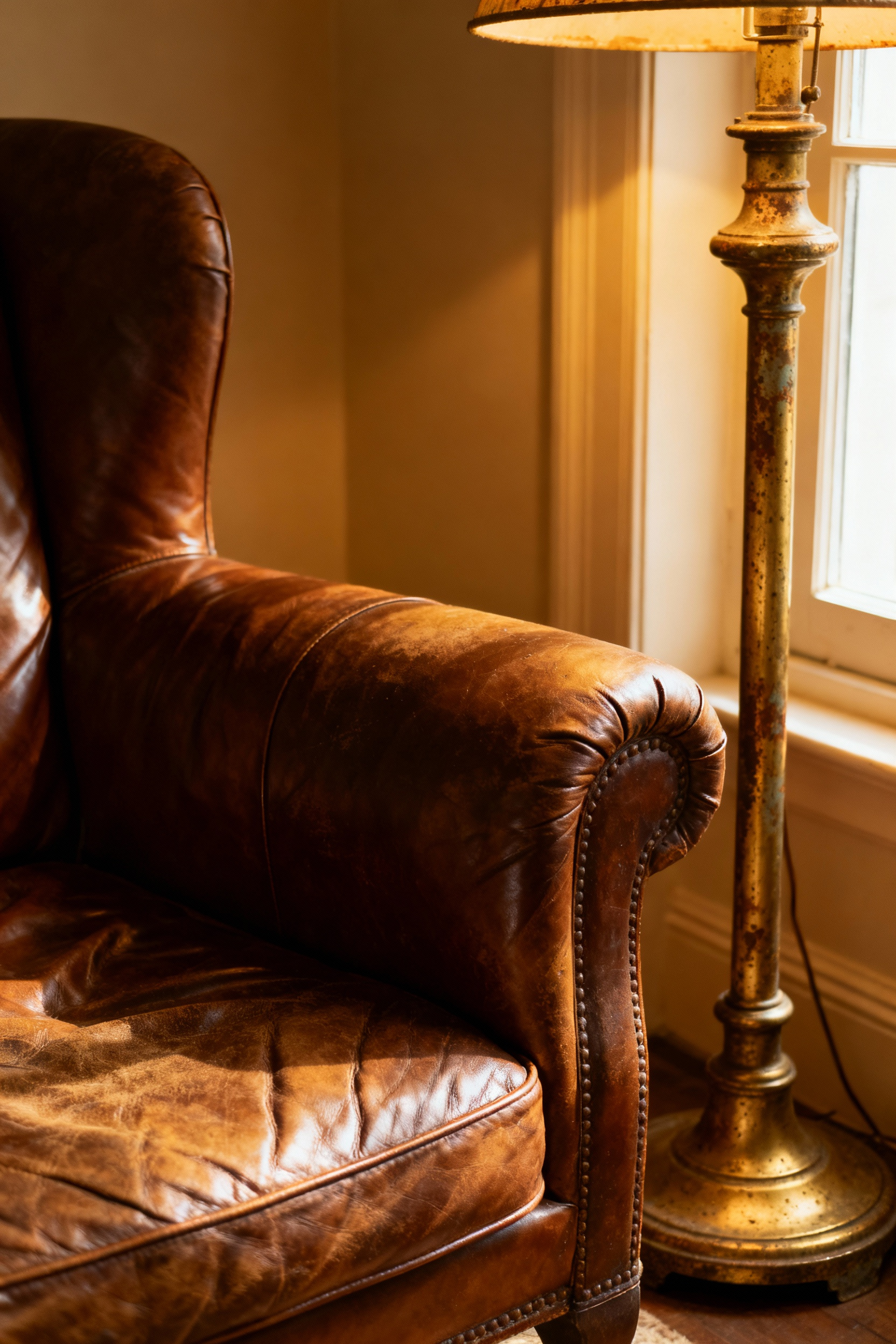
Don’t confuse patina with just being old or distressed. It’s about a well-loved leather chair whose arms are worn smooth, a vintage wooden chest with faint water rings, or a brass tray that’s no longer perfectly polished. These “flaws” are testaments to history and use. They communicate that this is a comfortable, welcoming space where perfection isn’t the goal. Pairing these aged pieces with modern, clean-lined elements creates a powerful dialogue between past and present, making your room feel rooted and real.
14. Calibrating Room Temperature and Air Quality for Optimal Physiological Comfort
Coziness is a full-body experience. You can have the most beautiful room in the world, but if it’s drafty, stuffy, or smells stale, you will never feel truly comfortable. We often ignore the “invisible architecture” of our homes: the air. Maintaining a consistent, comfortable temperature is a given, but also pay attention to humidity. Air that’s too dry can be irritating, while air that’s too humid feels heavy and oppressive.
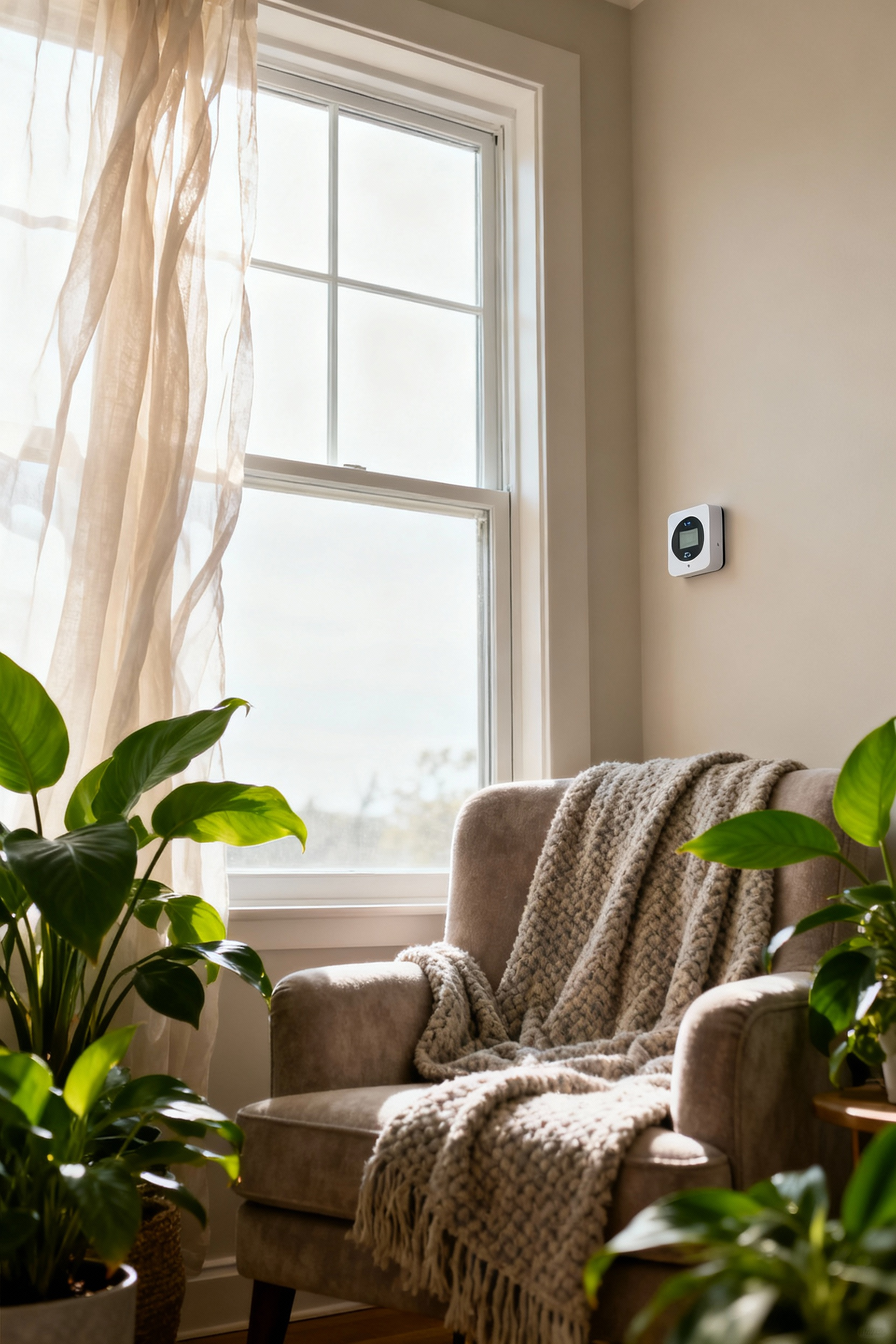
Take it a step further by focusing on air quality. An air purifier can make a remarkable difference, especially in a city or for those with allergies. Certain houseplants are also known for their air-purifying qualities. What I tell my clients is that managing your room’s microclimate—its temperature, humidity, and purity—is as important as any piece of furniture. It’s a foundational layer of comfort that directly affects your physiological state, allowing your body to relax on a cellular level.
Advanced Coziness Strategies: Architecting Emotional Resilience (Part 2)
Our final advanced strategy addresses the most pervasive source of modern unease: our constant digital connection. A truly resilient sanctuary must offer a refuge from this relentless input, creating space not just for physical rest, but for mental quietude as well.
15. Crafting a ‘Digital Detox’ Corner to Encourage Unplugged Presence
Your living room shouldn’t just be a place to passively consume media. To make it a true sanctuary, you must design a space that actively encourages you to disconnect. Designate one corner or even just one specific chair as a dedicated tech-free zone. This isn’t about getting rid of your devices; it’s about creating a visible, physical boundary.
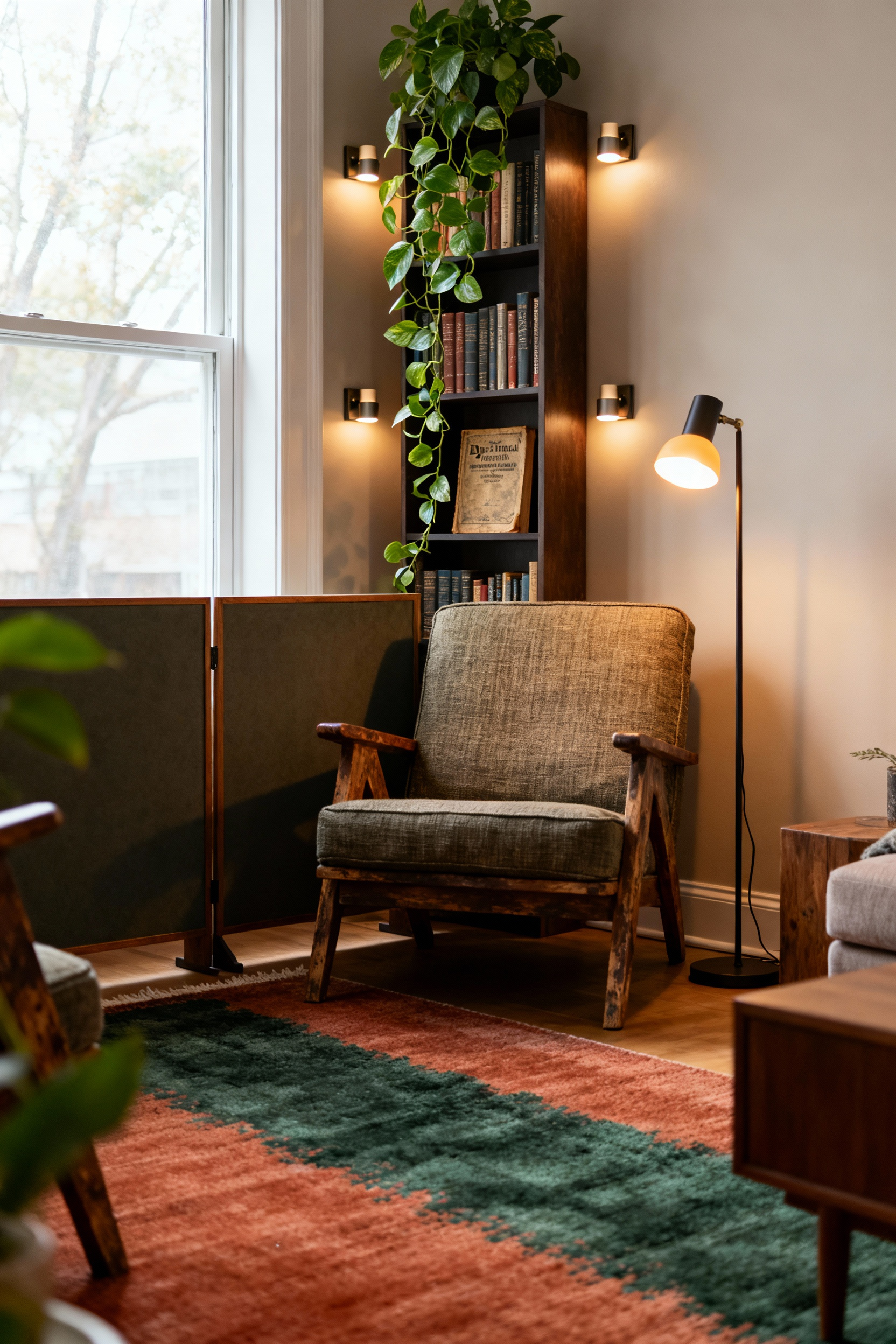
Furnish this corner with analog delights: a comfortable chair with excellent light for reading, a small table for a journal or a cup of tea, a turntable and your favorite records. The goal is to make the unplugged experience more compelling than scrolling. By providing an enticing alternative, you’re not relying on willpower to disconnect; the environment itself is doing the work for you. This one small act can radically change how you use your cozy living room, turning it from a place of distraction to a space for deep presence.
Mastering Cozy Living: The Holistic Integration of Sanctuary (Part 1)
At the highest level, a cozy living room transcends a collection of well-designed elements. It becomes a reflection of who you are—a holistic sanctuary where the very atmosphere reinforces your identity, your history, and your values. This is where we weave everything together into a deeply personal and resonant whole.
16. Cultivating Personal Narratives Through Curated Object Storytelling
A room filled with beautiful but anonymous objects from a big-box store will always lack a soul. True coziness comes from being surrounded by your own story. This goes beyond just displaying family photos. It’s about curating objects that hold personal meaning and arranging them to create a visual narrative.
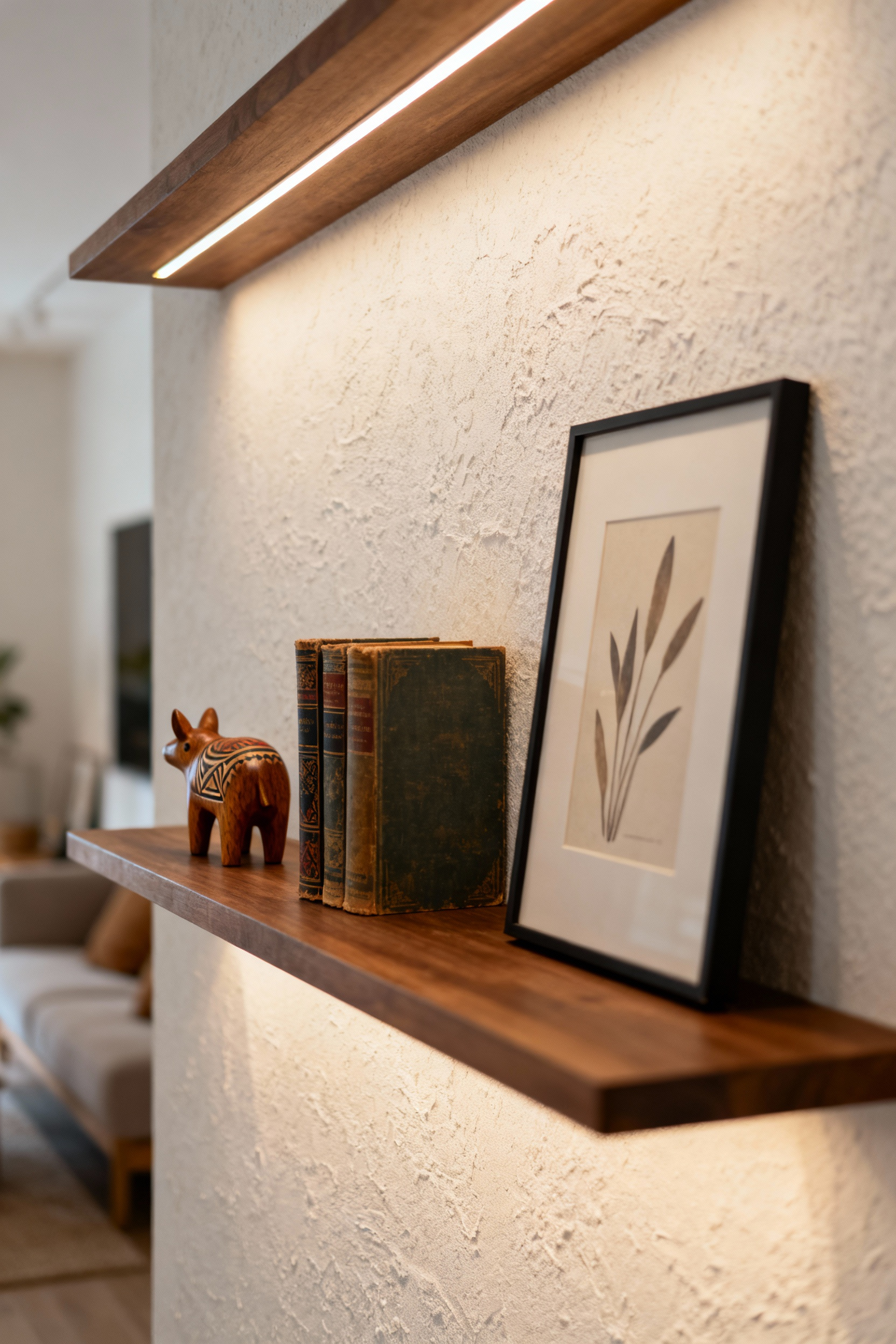
Think about a vignette on a bookshelf: a worn copy of your favorite book, a smooth stone from a memorable trip, a ceramic bowl made by a friend. Each object has a story, and together they tell a chapter of yours. What I advise my clients is to stop thinking about “decor” and start thinking about “artifacts.” These aren’t just things to fill space; they are tangible pieces of your life. By thoughtfully displaying them, your cozy living room becomes a living autobiography, a space that constantly and quietly reminds you of who you are and where you’ve been.
17. Employing Scent Scaping Techniques for Olfactory Memory Recall and Mood Enhancement
Scent is our most primitive sense, directly linked to the parts of the brain that process memory and emotion. A strategic approach to scent, or “scent scaping,” is one of the most powerful and underutilized tools for mood enhancement. Move beyond generic scented candles and think about creating a signature scent for your home.
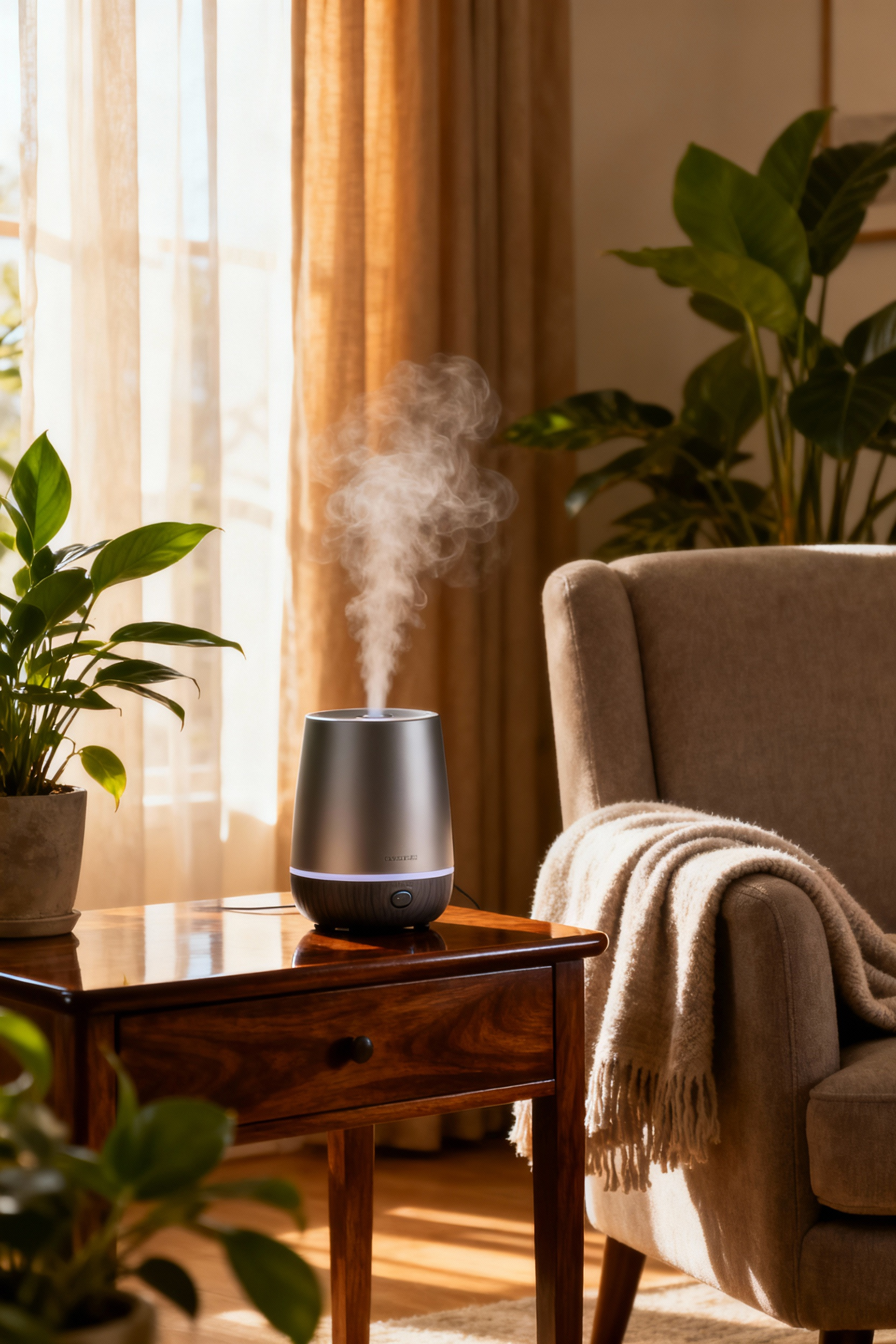
Use a diffuser with high-quality essential oils to create a custom blend—perhaps calming lavender and grounding cedarwood for the evening, or uplifting bergamot for the day. Over time, your brain will build a powerful association between that specific aroma and the feeling of being safe at home. It becomes an unconscious trigger for relaxation. A subtle, consistent scent story is far more effective than a loud, fleeting one, weaving an invisible layer of comfort throughout your cozy living room.
18. Designing for ‘Hygge’ and ‘Lagom’ Principles as a Philosophical Anchor
The Nordic concepts of ‘Hygge’ (Danish for cozy contentment) and ‘Lagom’ (Swedish for ‘just the right amount’) are not design trends; they are philosophies of living. Hygge is about creating an atmosphere of warmth, connection, and intimacy. Lagom is about finding balance, and appreciating quality and sufficiency over excess.
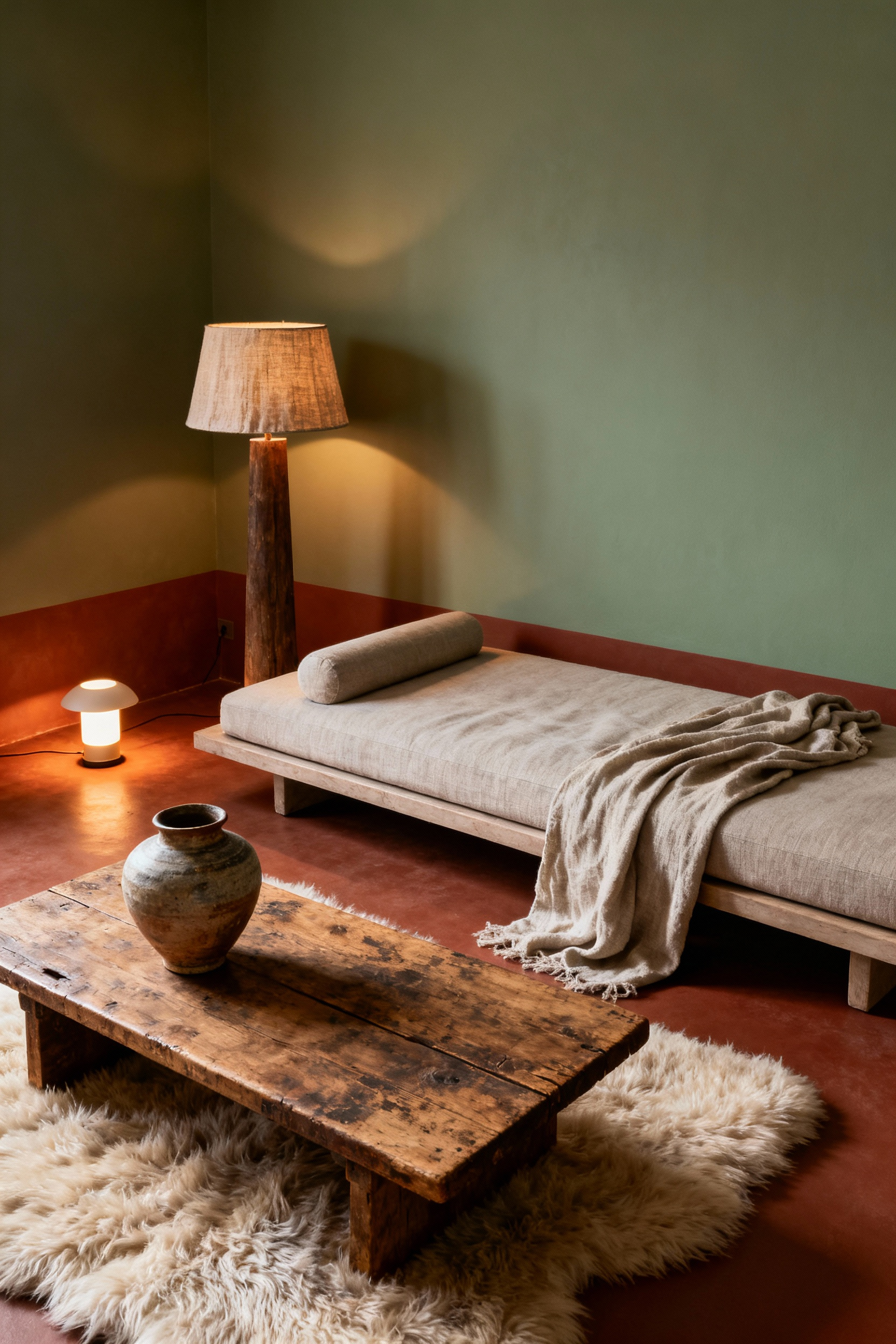
You can use these principles as your guide. When you’re choosing a sofa, Hygge asks: “Does this invite connection and long conversations?” When you’re decluttering, Lagom asks: “Is this truly necessary? Does it add value to my life?” A cozy living room designed with these philosophies becomes a space that feels both abundant in comfort (Hygge) and peacefully uncluttered (Lagom). It’s a physical manifestation of a balanced, intentional life.
19. Pre-empting and Resolving Visual Clutter with Discreet Storage Solutions
Clutter is the enemy of calm. The constant visual noise of stray items creates a low-grade stress that undermines any attempts at creating a cozy space. The master-level approach to storage isn’t about buying more bins; it’s about making storage invisible and intuitive.

Think architecturally. Can you use an awkward alcove for floor-to-ceiling built-in cabinets that blend into the wall? Choose furniture that does double duty, like a coffee table with hidden drawers or an ottoman that opens up. The goal is for storage to be so seamlessly integrated that you don’t even notice it. This proactive approach prevents clutter before it starts, preserving the visual peace of your cozy living room and making tidiness feel effortless.
Mastering Cozy Living: The Holistic Integration of Sanctuary (Part 2)
Finally, mastery is recognizing that both we and our homes are not static. The ultimate cozy living room is not a finished project, but a living, breathing space that evolves with us. It’s an environment that adapts to our changing needs, seasons, and life stages, offering a fluid and continuous sense of sanctuary.
20. Fostering an Evolving Living Space Through Adaptable and Modular Elements
The most profound sense of comfort comes from a space that feels like it was made just for you, right now. The secret to achieving this over the long term is building in flexibility from the start. Modular furniture is the most obvious tool—a sectional that can be reconfigured for a movie night, a party, or a quiet Sunday. Nesting tables can be spread out for guests or tucked away for more floor space.

But this philosophy goes deeper. Think about track lighting that can be repositioned to highlight different areas as your room’s function shifts. Use large, freestanding bookshelves as permeable room dividers that can be moved. Taylor Jones advises, “View your home not as a portrait, but as a conversation.” By choosing adaptable elements, you are designing a space that can respond to the natural ebb and flow of your life. It ensures your cozy living room remains a perfect fit for you, not just today, but for all the versions of you to come.
Conclusion
So, we’ve dismantled the myth. A genuinely cozy living room isn’t something you can purchase from a catalog. It’s not a superficial style you apply like a coat of paint. It’s a deeply resonant feeling, meticulously built from an understanding of human psychology, sensory input, and personal narrative.
What we’ve really been talking about is the science of sanctuary. We’ve moved beyond the “what” of design—the pillows, the colors—to the “why.” You now understand that lighting schemes can regulate your nervous system, textural contrasts can keep your mind gently engaged, and spatial flow can eliminate subconscious friction. The idea that coziness is accidental has been replaced by the empowering truth that it is an act of intentional creation.
You are no longer just a decorator; you are the architect of your own well-being. Take these principles, not as rigid rules, but as a new language for shaping your environment. Go beyond creating a room that just looks good and build a space that feels like a genuine refuge—a testament to the fact that profound comfort is the most intelligent design of all.






